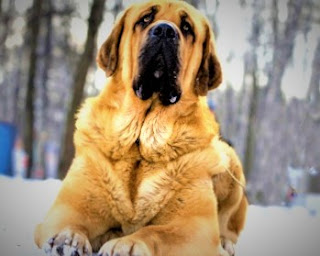Spanish Mastiff
History
The exact time of the origin of the Spanish Mastiff breed is
unknown, however, it is clear that these dogs were used by people in the Middle
Ages. Man in that distant time needed a dog that could perform many different
functions, being a universal and reliable assistant.
The duties of the animal, first of all, included the
protection of livestock and the protection of the infield territory, although,
many owners harnessed mastiffs in small carts. Given the huge size of the dog,
this was not a big problem for her. At home, it is still often called Perro
Marinero, since ancient times the Spaniards have been breeding merino
sheep.
With regard to the protection of livestock in pastures, the
Spanish Mastiff performed at its best and could be a serious threat to the
wolf. Moreover, do not confuse the Spanish Mastiff with a shepherd dog, since
he is not, strictly speaking, a shepherd. As herding dogs, other breeds were
used in conjunction with the mastiff, and the mastiff was an ideal guard and
thunderstorm for any predators wishing to attack sheep.
By the middle of the 20th century, the population of these
dogs in their homeland had declined. Although the Second World War did not
seriously affect the country, the reduction of farms, and hence the number of
livestock, led to a reduction in the number of Spanish Mastiff.
The FCI created the first breed standard for the Spanish
Mastiff in 1946. Association Española del Perro Mastín Español, an organization
created in 1981, was engaged in restoring the population of the breed and
recreating dogs of the old type, but with modern features, suitable for both
protection and family life.
Now, in addition to the officially recognized Spanish
Mastiff, there are 3 more varieties that are not officially recognized:
- Spanish mastiff;
- Leonian mastiff;
- Sobaka-wolf (wolf-mastiff).
Characteristics
of the breed
popularity 01/10
training 07/10
size 10/10
mind 10/10
protection 10/10
Relationships with
children 08/10
Dexterity 09/10
Molting 06/10
Breed Information
|
Country |
Spain |
|
Lifetime |
10-11 years |
|
Height |
Males: 77-88 |
|
Weight |
Males: 90-100 |
|
Length of coat |
average |
|
Color |
any monochromatic |
Description
These are large dogs with massive heads and muzzles having
folds. Also, large folds can be seen on the dog's neck. The ears are floppy.
The length of the coat may be shorter or longer depending on the region of
origin of the dog. Limbs of medium length, chest voluminous, powerful, physique
muscular, massive, the tail of medium length.
Personality
This huge, intimidating dog in relation to other people,
in fact, is surprisingly intelligent and restrained. Unreasonable aggression,
incorrect, inadequate behavior, and sudden mood swings - all this is completely
uncharacteristic of the Spanish Mastiff. On the contrary, with other people,
for example, on a walk, he will be restrained, patient, but at the same time
vigilant, while remaining ready to respond to any danger.
Protective and protective instincts are laid down in these
dogs genetically, therefore, training in this regard is minimized. Training,
for the most part, does not cause difficulties for an experienced owner. If, on
the contrary, you are a timid and indecisive person who also does not know how
to handle large dogs and even has feared for them, it is better to choose another
breed for yourself.
The Spanish Mastiff needs a leader for guidance, a steady
hand that knows what to do at any given moment. Other animals get along
normally, but it is better to do it at an early age. If they realize that they
are the guardian of their own territory, for example, in the backyard, behavior
towards strangers will be appropriate.
Any intruder or person who threatens the life and health of
the owners will be instantly attacked - such a person can only sympathize. If
the dog sees the location of the owner, he changes his attitude accordingly.
Children are perceived normally, but it is better not to leave small children
under five or six years of age alone with such a large dog. They have developed intellect, excellent memory, excellent reflexes and instincts, they
understand a person well even on an intuitive level.
Common diseases
The Spanish Mastiff has very good health and rarely suffers
from diseases. The most common are hip dysplasia, elbow dysplasia, skin
diseases.



.jpg)
.jpg)
0 Comments